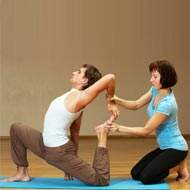Love Surfing? Try Paddleboard Yoga
With changing times, the face of one of the most ancient physical practices has also changed. Today, you can not only enjoy the subtle nuances of the various yoga poses and postures, but can combine it with various adventure sports and make it more interesting. Surfing, for instance, can today be combined with yoga to form the much more challenging and interesting paddle-board yoga.
A Paddle-board yoga class is typically performed on a beach or near a tidal source. This is a new trend for summer where yoga enthusiasts perform their yoga poses and postures on their surfboards. This is a kind of wet yoga, and if you are scared of getting wet or falling off the surfboard during the class, this is certainly not for you.
This is a fun yoga class for which you need to have a love for outdoor adventures. Some experience with yoga and paddle-board is best if you plan to attempt a paddle-board yoga class.
How to Perform paddle-board Yoga?
Paddle-board yoga is also often known as Stand Up Paddle-board yoga, or SUP yoga. In the initial classes, you will be performing the yoga poses on the beach, using your surfboard as a yoga mattress. As you grow proficient in your poses, you can take your paddle-board into the water and perform your poses on it. This is much more challenging because not only do you perform the poses, you also have to maintain your balance. As you stabilize the boat or the paddle-board on which you are performing the poses, you develop and strengthen your core as well. Some people only perform standing yoga poses on the surfboard while others enjoy performing Pilates as well.
Paddle-board Yoga Poses
Some of the most commonly performed poses on paddle-board are the Downward Facing Dog (Adho Mukha Svanasana), the Plank Pose, the Cobra Pose (Bhujangasana) and gentle push-ups. While performing the Downward Facing Dog pose, you have to move very slowly and carefully to maintain your balance on the board so that it does not topple over. This is a challenging pose when performed on water as it may take a lot of effort from even the most practiced yoga professionals.
The Plank and Cobra poses are slightly easier to perform, but the challenge lies in coming into the lying position from your standing position. The same applies for the push-ups as well. Once you are in the pose or the posture, you have to use some effort to maintain the posture. Push-ups are usually performed when you have mastered the skill of balancing on the paddle-board.
Benefits of Paddle-board Yoga
The main benefit of paddle-board yoga is core strengthening. As you perform the poses and try to retain your balance, you use the muscles in your core, thus strengthening them. This also helps you gain improvement in balance. Proponents of paddle-board yoga claim that this kind of yoga can also help in relaxing due to the gentle rocking motion of the water on which the yoga is performed.
Read more articles from the Yoga Exercises Category.

 Find Pose
Find Pose

